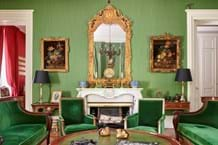Selective bidding accounted for the failure of some lots and the unexpected success of others – Edwardian rectangular mahogany serving table was unsold against expectations of £2000-3000 but a 5ft 4in (1.63m) wide, George III mahogany and box lined bowfront serving table with flowerhead capitals to square tapering legs, sold to a North England dealer at a treble-estimate £4600.
But it was also clear that high reserves played their part in the failure of highly rated lots such as a George II walnut bureau bookcase, estimated at £10,000-15,000 despite the removal of its mirror plates and an altered interior, and an 18th century Dutch walnut marquetry bombé bureau estimated at £6000-8000 (which went to a private buyer after the sale).
Whatever the motivation for unrealistic reserves, competition with local auctioneers did not play any part according to auctioneer Alastair Drennan, who pointed out that the only lot on which they faced competition with another firm (not, incidentally, Lyon and Turnbull) was their best seller – an early Victorian pair of rosewood tea tables.
Their bulky form suggested a Scottish origin, but the feather carving to their columns was an idiosyncratic feature which stumped even David Jones, the resident expert in Scottish furniture. Each measuring 3ft 21/2in wide by 19in deep (98 x 48cm), adorned with scrolls and supported on concave platforms with paw feet, the tables were certainly a glamorous pair, and 30 years ago had supposedly been purchased separately for £200 and £400 – no mean sums of money back then – at a Scottish auction house. On this occasion they were chased by the English trade but eventually sold to a Scottish dealer at £14,000.
Group consignments of quality goods are on the wane in the auction world, but Phillips were fortunate enough to receive from one source three of their finer entries – a pair of George II mahogany hall chairs, a George III mahogany serpentine chest and a George III mahogany and tulipwood banded secretaire bookcase.
Furnishings for hall and libraries have the status, real or imagined, of country house furnishings, and have consequently leapt in price since the last recession. If rich men cannot always buy titles, they can always buy titled men’s furniture, and the crest of Rear Admiral Sir James Bremner, KCB (1786-1850) certainly added to the value of this pair. Comprising shaped rounded backs on circular drop-in seats upholstered in gros and petit point needlework tapestry supported by cabriole legs, claw ball feet and later cross stretchers, the chairs were entered in relatively good, clean condition and sold to the English trade at £9500.
The George III mahogany serpentine chest was “very straightforward’, said Mr Drennan. Comprising four long cockbeaded drawers on bracket feet, 3ft 9in (1.14m) wide, it sold to the trade within expectations at £5800.
The secretaire bookcase was of the Edinburgh type with banded roundels to the cupboard doors and gothic moulding to the cornice. This would have been enough to conjure a high price from a local private buyer under normal circumstances, but the bookcase was rather cumbersome, measuring 7ft 9in high by 4ft 4in wide (2.37m x 1.32m), and moreover had sustained damage to the cornice and a split down one side, factors which held Scottish trade bidding down to £3700.
Phillips, Edinburgh, December 16
Number of lots offered: 245
Number of lots sold: 200
Sale total: n/a
Buyer’s premium: 15/10 per cent
£14,000 tables to choosy bidders’ tastes
UK: A SUBSTANTIAL offering of furniture, most of it 19th century and brown, received a mixed response from the Scottish and North of England trade at the last Phillips sale in Edinburgh before Christmas.




